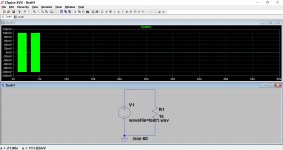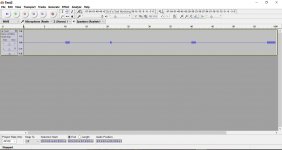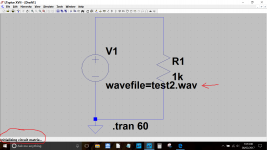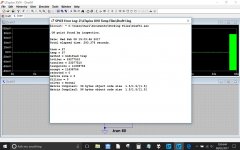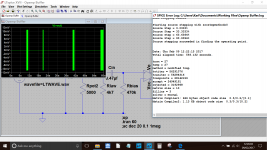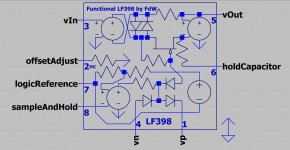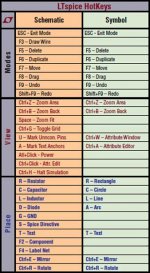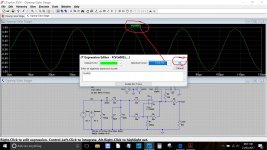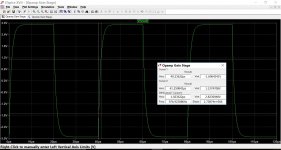Can you reduce the example size a bit... for example...what happens with a short file, with 1 second of silence, 1 second tone, and 1 second fade.? That file would be small enough for you to post, so we could try opening it in a number of apps that understand wav.
It might let us point a finger at either the format, or the understanding of that format by LTSpice. BTW...which LTSpice are you using?
It might let us point a finger at either the format, or the understanding of that format by LTSpice. BTW...which LTSpice are you using?
Thanks.
A bit more testing with this and it seems also related to file size. A short 10 second file does let me fade and add silence OK. A 60 second one doesn't.
-------------------------------------------------------------------------------------------
Attached is the .asc file with a 60 second .tran command.
Test1.wav and image of that running attached. This works instantly. This was a 10 second .wav file.
Test2.mp3 is an MP3 that can be imported into Audacity (or other program) and resaved as a .wav This is one that will not run. Image attached of how it looks. The original created .wav and the .wav to MP3 and back to .wav both behave the same.
The zipped folder contains the MP3 file.
A bit more testing with this and it seems also related to file size. A short 10 second file does let me fade and add silence OK. A 60 second one doesn't.
-------------------------------------------------------------------------------------------
Attached is the .asc file with a 60 second .tran command.
Test1.wav and image of that running attached. This works instantly. This was a 10 second .wav file.
Test2.mp3 is an MP3 that can be imported into Audacity (or other program) and resaved as a .wav This is one that will not run. Image attached of how it looks. The original created .wav and the .wav to MP3 and back to .wav both behave the same.
The zipped folder contains the MP3 file.
Attachments
I just tried the experiment with LTspice IV under windows 7.
I cut the time down to .tran 15. It then says, "Initializing Circuit Matrix".
This lasts for around 3 minutes, and then it ran. I wonder...if you do this with 60 seconds, does it take 12 minutes to get ready to run a 60 second sim?
I cut the time down to .tran 15. It then says, "Initializing Circuit Matrix".
This lasts for around 3 minutes, and then it ran. I wonder...if you do this with 60 seconds, does it take 12 minutes to get ready to run a 60 second sim?
Thanks for trying that, appreciate it. I've just this minute set it running in LTIV.
I'll keep looking in on it and report back later.
I'll keep looking in on it and report back later.
So it worked coming in at a shade under 300 seconds. This was on a 10yr old laptop (AMD64 Turion +2Gb ) running W10.
My Dell with an SSD sounded like it was going to take off when I tried this yesterday. Never before heard the fan ramp up to the speed that it did.
And thanks again for trying it. I'll perhaps have a bit more of a play with all this now.
My Dell with an SSD sounded like it was going to take off when I tried this yesterday. Never before heard the fan ramp up to the speed that it did.
And thanks again for trying it. I'll perhaps have a bit more of a play with all this now.
Attachments
This is pretty cool.
I tried this on the Dell feeding a more complex circuit, and it took 600 seconds to run. Strange to say the fan activity (which I know is normal when doing something intense) comes back down to more reasonable levels after a minute or two.
I tried this on the Dell feeding a more complex circuit, and it took 600 seconds to run. Strange to say the fan activity (which I know is normal when doing something intense) comes back down to more reasonable levels after a minute or two.
Attachments
Just to make sure I am understanding, we can use a WAV file as source to a circuit, save the output as WAV file, and "hear" the effect of our circuit without actually building it? Granted, this relies heavily on the models being realistic, but that is still impressive.
Found this simple guide, although their comments make this sound like it will be a job for my desktop...
Found this simple guide, although their comments make this sound like it will be a job for my desktop...
That's about the long and short of it, yes. I would expect it would take some serious computing power/and/or/time to do anything worthwhile.
This is a good link:
Solutions - LTspice: Importing and Exporting WAV & PWL Text Files
This is a good link:
Solutions - LTspice: Importing and Exporting WAV & PWL Text Files
You might need a bigger desktop 😉
I've just had a sim running for 6 hours on my old laptop and it has reported 'out of virtual space' having apparently filled an empty 320Gb drive (that I set up specifically for temp files for this) with the temp files needed for this particular run... however 😀 me has learnt much 😉 and shall be having another play. I did get 30+ seconds of useful info for my trouble though.
I've just had a sim running for 6 hours on my old laptop and it has reported 'out of virtual space' having apparently filled an empty 320Gb drive (that I set up specifically for temp files for this) with the temp files needed for this particular run... however 😀 me has learnt much 😉 and shall be having another play. I did get 30+ seconds of useful info for my trouble though.
Very interesting. I will have to give this a shot on my desktop.
Have a look here 😉
http://www.diyaudio.com/forums/lounge/303727-welcome-virtual-listening-room.html#post4986951
Functional LF198/LF298/LF398 Sample And Hold
Not willing to start a new thread for this, I just post it here 🙂
This is a functional LF198/LF298/LF398 model (because it functions for me), if any one is in need for a functioning 'Sample And Hold' he could start by giving this a try.
Not willing to start a new thread for this, I just post it here 🙂
This is a functional LF198/LF298/LF398 model (because it functions for me), if any one is in need for a functioning 'Sample And Hold' he could start by giving this a try.
Attachments
That's great  I will add it to the index on page 1 (there is a section there for this kind of thing)
I will add it to the index on page 1 (there is a section there for this kind of thing)
 I will add it to the index on page 1 (there is a section there for this kind of thing)
I will add it to the index on page 1 (there is a section there for this kind of thing)Hi,
..just finished reading the whole thread beginning from post #1 to post #755. I thank you all guys for all the informative inputs.
Mooly,
Huge thanks goes to you for putting up this thread.
More power to you!
..just a few basic questions here;
1) how do you create a ground symbol that had its arrow pointing up instead of pointing down[default], rotate function does not seem to do the trick..🙁
2) scanning the log file, if it shows rejected number does it mean that the simulated result is also faulty?
3) The warning multiple models detected, is it good or bad?
Lastly can anyone point me to a link showing how to properly simulate "slew rate" of an amplifier. Is it a dc pulse in the input source and apply it directly at the input base of the input transistor but at what parameters should it be? [sorry offtopic]
Regards,
Albert
..just finished reading the whole thread beginning from post #1 to post #755. I thank you all guys for all the informative inputs.
Mooly,
Huge thanks goes to you for putting up this thread.
More power to you!
..just a few basic questions here;
1) how do you create a ground symbol that had its arrow pointing up instead of pointing down[default], rotate function does not seem to do the trick..🙁
2) scanning the log file, if it shows rejected number does it mean that the simulated result is also faulty?
3) The warning multiple models detected, is it good or bad?
Lastly can anyone point me to a link showing how to properly simulate "slew rate" of an amplifier. Is it a dc pulse in the input source and apply it directly at the input base of the input transistor but at what parameters should it be? [sorry offtopic]
Regards,
Albert
Member
Joined 2009
Paid Member
it will auto-rotate depending on the direction of the wire that connects to it so that it sits at the end of the wire. If you want it pointing up, make sure the wire is pointing down...just a few basic questions here;
1) how do you create a ground symbol that had its arrow pointing up instead of pointing down[default], rotate function does not seem to do the trick..🙁
it means you have two models for the same component, you'd be better off if you eliminated one of them.3) The warning multiple models detected, is it good or bad?
it will auto-rotate depending on the direction of the wire that connects to it so that it sits at the end of the wire. If you want it pointing up, make sure the wire is pointing down.
it means you have two models for the same component, you'd be better off if you eliminated one of them.
Bigun,
thank you, so the trick is where the wire tap is coming from. 😎
I found this image in the net, I'm not a heavy shortcut key user, hope anyone may find it useful. Not sure though if it also works with the later LT17 version.
Attachments
...forgot one thing, how do you audio guys set the parameters in the control panel? Will default setting work fine in analysing amplifier circuits?
Anyone wanted to answer question no.2 in post #756?
Thanks a lot!
BTW, LT17 crashes a lot in my Win10 x64, it also does not recognize copy pasted models in their designated folder/files in the default installation directory and also to the my documents directory. Tried it with no luck even using a powerful programming languange editor like Notepad++. 🙁
Anyone wanted to answer question no.2 in post #756?
Thanks a lot!
BTW, LT17 crashes a lot in my Win10 x64, it also does not recognize copy pasted models in their designated folder/files in the default installation directory and also to the my documents directory. Tried it with no luck even using a powerful programming languange editor like Notepad++. 🙁
Thanks for the kind words 🙂
Slew rate of an amplifier can be determined by squarewave testing. Right click the voltage label on the graph and select add two cursors. You can then move them to be 1uS apart and calculate (read off) the rate of change.
I haven't had any crashes with LTXVII but yes, it is fundamentally different in many aspects.
Not quite sure what you are seeing and what results you are getting with the log file. We'd have to see it in action I think.
Slew rate of an amplifier can be determined by squarewave testing. Right click the voltage label on the graph and select add two cursors. You can then move them to be 1uS apart and calculate (read off) the rate of change.
I haven't had any crashes with LTXVII but yes, it is fundamentally different in many aspects.
Not quite sure what you are seeing and what results you are getting with the log file. We'd have to see it in action I think.
Attachments
- Home
- Design & Build
- Software Tools
- Installing and using LTspice IV (now including LTXVII), From beginner to advanced
